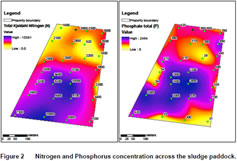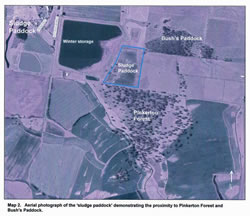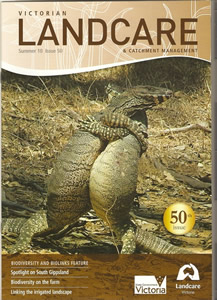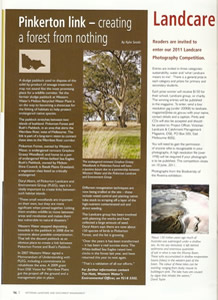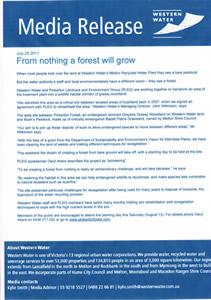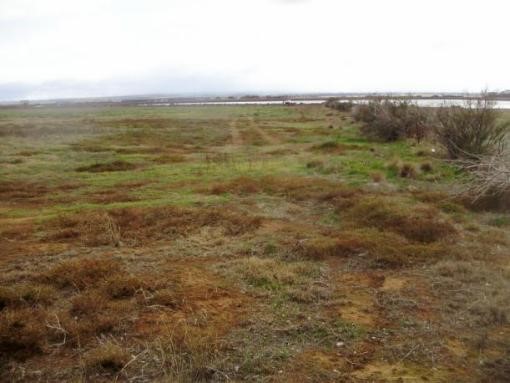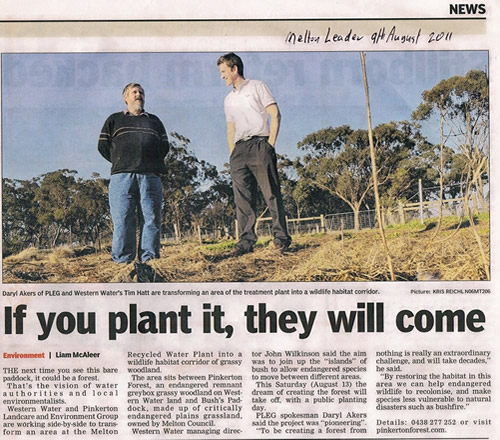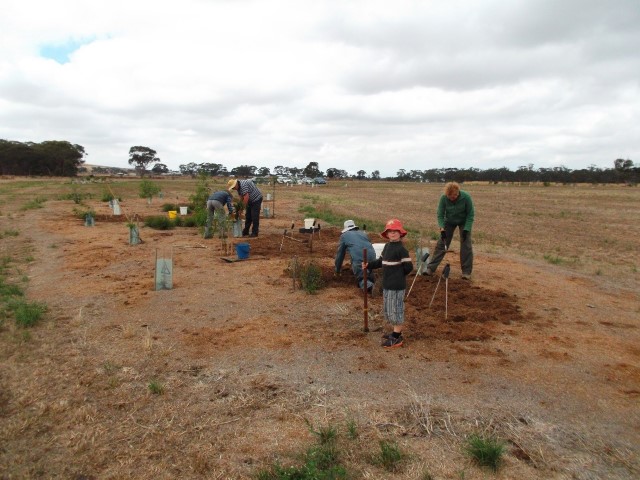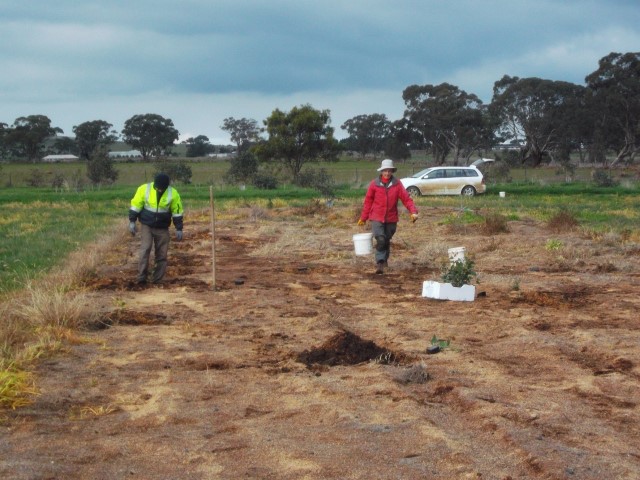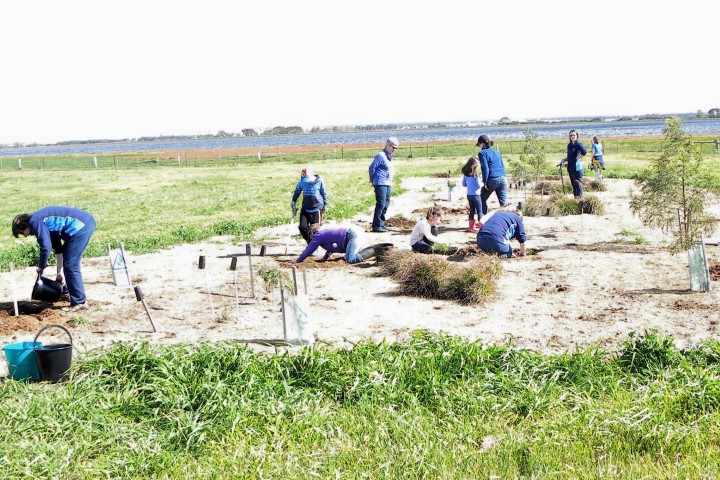The Pinkerton Link Story: creating a forest out of nothing!
In the beginning: there was the Sludge Paddock!
1. Background 2010
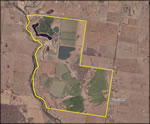 Western Water owns a 692 hectare property at Butlers Rd, Mt. Cottrell where it operates the Melton Recycled Water Plant (RWP). A large part of the property is currently leased for farming activity using recycled water from the Melton RWP. The majority of the property consists of agricultural pasture but also incorporates wastewater lagoons and infrastructure, agricultural structures and areas of native vegetation such as Pinkerton Forest and the Werribee River. Melton RWP is within the Victorian Volcanic Plains (VVP) bio-region and is found 1 kilometre west of Mt Cottrell.
Western Water owns a 692 hectare property at Butlers Rd, Mt. Cottrell where it operates the Melton Recycled Water Plant (RWP). A large part of the property is currently leased for farming activity using recycled water from the Melton RWP. The majority of the property consists of agricultural pasture but also incorporates wastewater lagoons and infrastructure, agricultural structures and areas of native vegetation such as Pinkerton Forest and the Werribee River. Melton RWP is within the Victorian Volcanic Plains (VVP) bio-region and is found 1 kilometre west of Mt Cottrell.
Western Water, in association with Pinkerton Landcare and Environment Group (PLEG), has been undertaking biodiversity enhancement works in Pinkerton Forest for 20 years and along the Werribee River valley for the last ten years. Pinkerton Forest can be found in the centre of the Melton RWP and consists of approximately 35 ha of remnant plains grassy woodland. Approximately 3.8km of river frontage exists where the Werribee River borders the western boundary of Surbiton Park and cuts a deep volcanic gorge in the landscape. The Werribee River valley contains patches of poor-medium quality remnant native vegetation. Western Water has to date been undertaking revegetation works along approximately 2km of Werribee River frontage in partnership with Melbourne Water and PLEG.
Bordering Surbiton Park is a Melton Shire Council owned remnant native vegetation patch known as Bush's Paddock which lies approximately 370 metres north of Pinkerton Forest. Pinkerton Forest and Bush's Paddock are separated by an area of land on Melton RWP which has previously been used for the controlled disposal of sludge from the waste water treatment process. This area, once known as the 'sludge paddock', is no longer used for disposal of sludge. Deposition of high nutrient wastes by Western Water ceased in 2007.
Western Water has recognised that management input is required to ensure the long-term persistence and enhancement of biodiversity values of Melton RWP due to a general awareness of best practice environmental management, planning and compliance with statutory obligations.
The old-Sludge Paddock Pinkerton Link (now known as Pinkerton Link) is 12ha in size and contains eight mature grey box trees.
2000 - 2010
Several small plantings were undertaken by PLEG on the narrow strip on the eastern side of the access track, this was in a nutrient free area, a few Sweet Bursarias and a Drooping Sheoke have survived. The casuarina was grown from local seed by Irene Cook PLEG member.
2. Project Description
In recognising the biodiversity values of the property, Western Water would like to further enhance the biodiversity attributes of Melton RWP by creating a habitat corridor between Pinkerton Forest and Bush's Paddock by revegetation of the sludge paddock with indigenous flora species. The habitat corridor will link the two fragmented remnant vegetation patches and allow native fauna to traverse between the two areas, enhancing the significance and importance of the two sites. Western Water has received joint funding for the project through the Vision for Werribee Plains (V4WP) grants program run by the Department of Sustainability and Environment.
Pinkerton Forest
Pinkerton Forest is a remnant Plains Woodland approximately 35 hectares in size. The vegetation is mostly comprised of mature Grey Box (Eucalyptus microcarpa) with a moderate quality understory due to a history of cattle and sheep grazing. In 1992 Pinkerton Forest was fenced and rabbit proofed and has since been managed to improve the biodiversity of the forest. Grassy Eucalypt Woodlands of the Victorian Volcanic Plains have recently been listed as critically endangered under the Environmental Protection and Biodiversity Conservation (EPBC) Act 1999.
Bush's Paddock
Bush's Paddock is a Melton Shire Council owned reserve located on the north east boundary of the 'sludge paddock' and has had a long history of stock grazing however recent plantings, weed and pest animal control is beginning to restore the site. The vegetation is remnant Plains Woodland but also contains large areas of native grassland. Natural Temperate Grasslands of the Victorian Volcanic Plains are also listed as critically endangered under the EPBC Act 1999.
Pinkerton Forest and Bush's Paddock are vegetation relics of pre-European settlement and provide many habitat opportunities for ingenious fauna species. Within a five kilometre radius of the Melton RWP, a total of 380 hectares of grassy eucalypt woodlands exist in four fragmented patches and is a hotspot for this type of vegetation community.
Pinkerton Forest and Bush's Paddock are examples of fragmented vegetation or habitat islands. Animals in an 'island' situation are vulnerable to catastrophes such as disease, bushfire and gradual changes like inbreeding and variations in climate. Significant fauna species have been recorded in these vegetation communities.
The habitat corridor will provide native fauna with a larger habitat area, increased available food supply and promote healthier and larger populations. The link will also create a greater likelihood of sustaining populations which undergo any fluctuations or catastrophes.
Scraping of the southern area would begin at the end of Year 1. Seed collection for direct seeding of scraped area would also occur in Year 1 during spring or when appropriate.
A corridor along the area east of the north-south access track will be constructed in Year 1. This would involve multiple herbicide applications followed by tube stock plantings of tree and shrubs species. Work on a corridor would begin ASAP, last planting could be undertaken as late as September. Northern area following cropping would be subject to multiple herbicide applications followed by plantings at end of Year 2/Year 3. Seed collected during Year 1 and two would be used to germinate stock. Direct seeding of native grass species could introduced to this northern area in Year 3. Direct seeding could be hand broadcast or GA direct seeder.
3. Status of Sludge Paddock 2010
The sludge paddock has been used for controlled disposal of liquid sludge from waste water treatment process for 20 years. The disposal of sewage sludge over many years has altered the profile of the soil surface in comparison to the surrounding land. The disposal of this material may have also increased the nutrient loading in the soil. However the disposal sludge has ceased more than two years ago and it is expected the nutrient concentration would have reduced. Soil analysis may be required to determine any constraints to the revegetation process. The consultant is not expected to conduct the soil testing, however, should advise Western Water on types of analyses and the extent of soil testing required. The consultant is expected to interpret the data to determine the possible impact on vegetation and recommend any alteration to the site to minimise adverse impact on vegetation.
Soil analysis of Nitrogen and Phosphorous in the soil determined that the sludge in the southern half of the paddock needed to be scraped the depths were 10 - 20cm as mentioned in the text. This has been completed which is an achievement.(Click to view enlarged Image)
Eight mature remnant Grey Box trees exist scattered throughout the paddock. There is also a mixture of indigenous shrub species along the eastern and northern fence lines comprising Tree Violet (Melicytus dentatus) and Golden Wattle (Acacia pycnantha).
The understory across the majority of the paddock is a mixture of introduced annual grasses, herbs and prostrate shrubs. High priority species for control may include but not limited to Galenia (Galenia pubsecens), African Boxthorn (Lycium ferocissimum), and Serrated Tussock (Nassella trichotoma). Lower priority species are present onsite including Toowoomba Canary Grass (Phalaris aquatica), Kikuyu (Pennisetum clandestinum) and Wild Turnip (Brassica sp.).
The long term objective of Western Water is to transform the 'sludge paddock consistent with the existing woodland habitat that exists to the north and south. In order to meet this long term objective, Western Water wishes to develop a detailed Revegetation Management Plan for the sludge paddock.
The group agreed on protection of the remnant Grey Box trees in sludge paddock as a priority.
Pinkerton Link
This photo illustrates the importance of the 'Sludge Paddock' as a link between Bush's Paddock and Pinkerton Forest. Hence its new name of 'Pinkerton Link.'
Also, the name 'Pinkerton Link' is much more environmentally appropriate than 'Sludge Paddock'!
The Pinkerton Link, will eventually be part of a contiguous Grey Box Woodland.
(Click to view enlarged Image)
Long term strategic planning for Grey Box Woodland precinct
Long term strategic planning for PLEG is to seek funding to acquire part or all of the privately owned property between Pinkerton Forest and Bush's Paddock. This will create a much more environmentally viable Grey Box Woodland.
The creation of the Pinkerton Link Project was celebrated in Victorian Landcare magazine in 2010.
|
|
|
The Sludge Paddock in 2009 prior to environmental restoration works
|
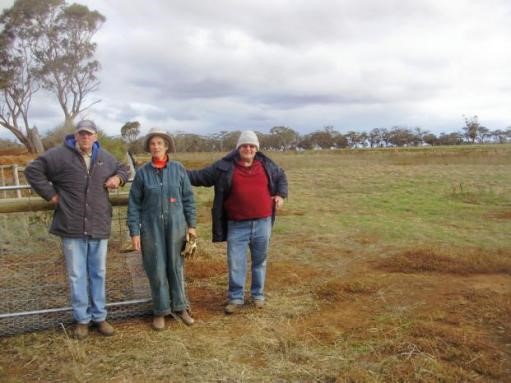 |
| Peter Gibbons, Frances Overmars (PLEG) and Alan Benson (Friends of Melton Botanic Gardens) at the Sludge Paddock in 2009, prior to environmental restoration works |
In 2009 Western Water applied for a grant for 'Pinkerton Forest and Bushs Paddock Biodiversity Corridor' from Vision for Werribee Plains, DSE. This was successful and a Project Control Group was formed, these members were from DSE, WW and PLEG. The project began with an intensive weed control programme.
Barley cropping and sheep grazing contributed to removal of nitrogen from the soil.
The seed for the revegetation has been sourced from either Pinkerton Forest, or its extension within Bushs Paddock.
The Pinkerton Link Story: creating a forest out of nothing!
Creating the forest begins: August 2011
On Saturday 13th August 2011 Western Water and Pinkerton Landcare and Environment Group (PLEG) invited the community to join them planting between Pinkerton Forest & Bush's Paddock, near Mount Cottrell. This was in fact an invitation to participate in the beginning of an innovative project to grow a Grassy Woodland from scratch!
Entry to the site was made through Western Water's treatment plant at Surbiton Park via Butlers Road at Strathtulloh, to avoid disturbing a nesting pair of endangered Sea-Eagles.
On the Friday prior to the community planting day, holes were drilled by contractors and the eucalyptus mulch was spread around the remnant Grey Box trees.
Close to 30 people turned up and we planted almost 1,000 grasses, herbs and trees. Participants were from groups as varied as Melton Bushwalkers, Girl Guides and Scouts, as well as other interested members of the community. We also distributed the cleaned Austrostipa scabra (Speargrass) and Austrodanthonia (Wallaby Grass) seed in half of the scraped area in the centre of the paddock. And we are thrilled it has rained which will help to settle the plants in.
This ambitious and innovative project by Western Water aims to achieve nothing less than to replant a forest on a paddock that is at present virtually devoid of native vegetation!
Many of the plants for the Sludge Paddock Restoration Project were grown under the supervision of Judy Allen indigenous plant expert at the Dame Phyllis Frost Centre Earlier this year PLEG and MEG supplied the centre with local indigenous seeds to grow wildflowers for sites in Melton and at Pinkerton Forest. Judy is a TAFE teacher at the Dame Phyllis Frost Centre teaching a course in Horticulture. Judy spoke to local environmental groups in May at Melton Shire Council. The Centre has grown a number of plants for local revegetation, which are now ready for planting. Judy attended the planting day to report back on where their seedlings were planted.
Many thanks to Judy Allen and the women at the Dame Phyllis Frost Centre for helping us create a forest on this empty paddock. Many thanks to everyone who turned up on this historical occasion to begin the long process of planting a forest here.
Pinkerton Link: the work continues 2012
Pinkerton Link: 2013
The Pinkerton Link Story: creating a forest out of nothing!
Pinkerton Link: 2014
On Sunday 6th April 2014 Pinkerton Landcare and Environment Group returned to Pinkerton Forest to plant in Pinkerton Link. Eight people planted a variety of native grasses and Pale Flax lilies. These plants will form part of the understory of the forest that was begun in 2011. In August 2011 Pinkerton Landcare and Environment Group (PLEG) began planting on the bare paddock between Pinkerton Forest and Bush's Paddock, near Mount Cottrell. Pinkerton Forest and Bush's Paddock are separated by an area of land on Melton Recycling Water Plant. The Pinkerton Link project will connect these two woodland remnants.
Many of the Grey Box trees are already over a metre tall and a direct seeded stand of native grass is also over 1.5 metres in height. Although we were kept busy planting, we still observed a total of 11 species of bird. These were Black Kite, Australian Magpie, Brown Thornbill, Yellow-rumped Thornbill, Golden-headed Cisticola, Jacky Winter, Little Raven, White-plumed Honeyeater, Willy Wagtail and Zebra Finch. It is an encouraging sign to see so many birds in what was only a short time ago a bare paddock.
|
|
| Tom and volunteers planting in Pinkerton Link April 2014 |
In September Irene and Daryl weeded the plants previously planted there in April. We noticed that the Kangaroo Grass (Themeda) tussocks were all growing well and even had tall flowering stalks. We also noticed that the Kangaroo Grass was been trimmed by kangaroos. However the grazing had been limited to the new leaves, leaving the tall flowering stalks untouched. These are no doubt the seven Grey Kangaroos resident in nearby Bush's Paddock, illustrating that Pinkerton Link is already providing a wildlife link.
In August Frances and Daryl of PLEG and William of Western Water returned to again at Pinkerton Link. We planted a number of Grey Box in the plot covered in rice hull mulch. We found the soil beneath the rice hulls to be soft and moist, proving excellent planting conditions.
|
|
| William and Frances planting Grey Box trees at Pinkerton Link |
Planting at Pinkerton Link with students from Westbourne Grammar School, Western Water, Western Land Services and volunteers, on 28th August 2014
On Wednesday 28th August there was a massive planting event at Pinkerton Link by students from Westbourne Grammar School, staff from Western Water and Western Land Services, members of PLEG, as well as several volunteers. A recently retired teacher from Westbourne even turned up, to the surprise of Westbourne staff and students, giving all a chance to reminisce.
We planted as grand total of 1,084 plants. This may well be a record for this site.
Bacchus Marsh Girl Guides at Pinkerton Link Sunday 31st August 2014
On Sunday 31st August a group of Girl Guides from Bacchus Marsh, accompanied by their Leaders and parents participated in the Pinkerton Link Project, helping us 'grow a forest from nothing! They planted about 100 plants, including Wallaby Grass, Spear grass and four Grey Box trees. Hopefully they may return one day, some years into the future and find a Grey Box Woodland here with native grasses and understory; and reflect on their part in its creation. Again we enjoyed a magnificent sunny morning, with a warm breeze. A fitting end of winter.
We planted in three plots situated at the northern end of the paddock. As these trees grow to maturity we expect them to provide a windbreak against the hoy northerlies that blow across here in summer. This should shelter the plants downwind, protecting them from the frying influence of these winds. Also, as these plants mature and set seed, their seeds will be blown downwind into the paddock, causing natural regeneration of native plants.
The Girl Guides would like to return and plant next year, to once more participate in planting a forest. Planting a forest from nothing is a once in a lifetime opportunity.
|
|
| Bacchus Marsh Girl Guides, Leaders and parents planting in Pinkerton Link |
The list of groups who have participated in this project is constantly expanding!
Planting innovations at Pinkerton Link
An innovation was the use of several jute mats to combat competition from weeds that grow rampantly in the highly fertile soil.
Another innovation is the creation of a series of 'islands of excellence'. Instead of trying to completely restore the entire 12 hectare paddock, we are concentrating on planting within discrete 'islands' and building up the native biodiversity content, and maintaining these intensively. As these islands are restored the intention is to link them up.
Daryl Akers, October 2014

